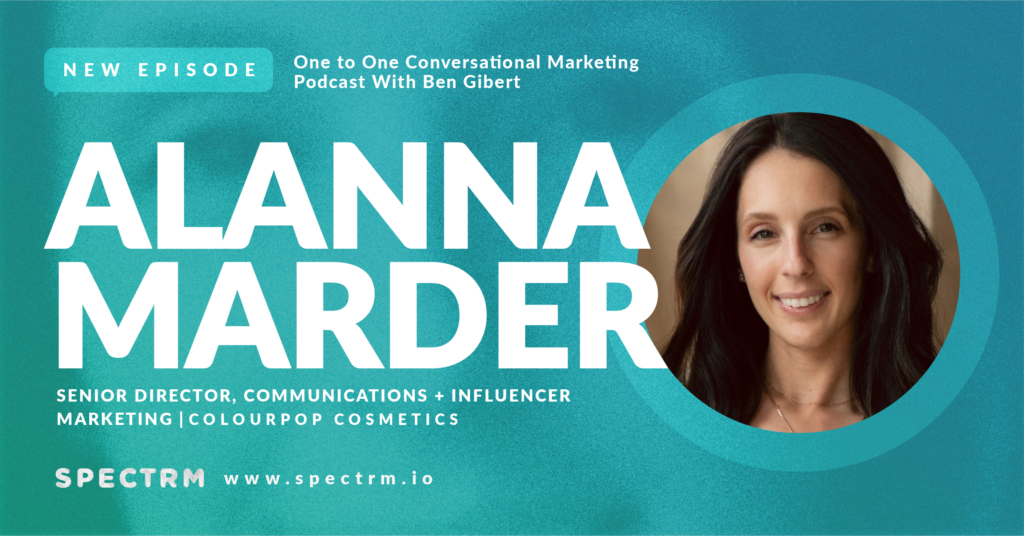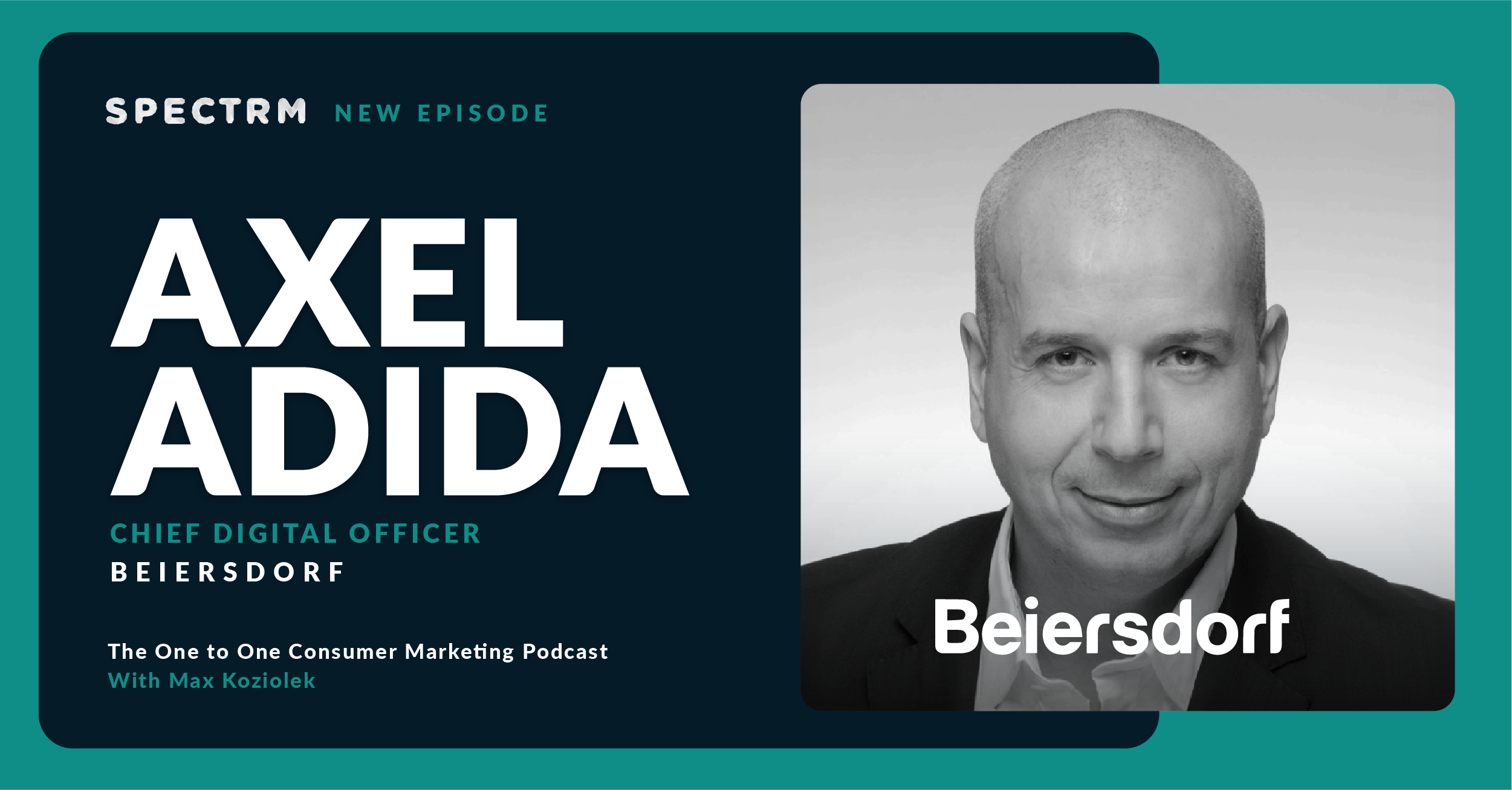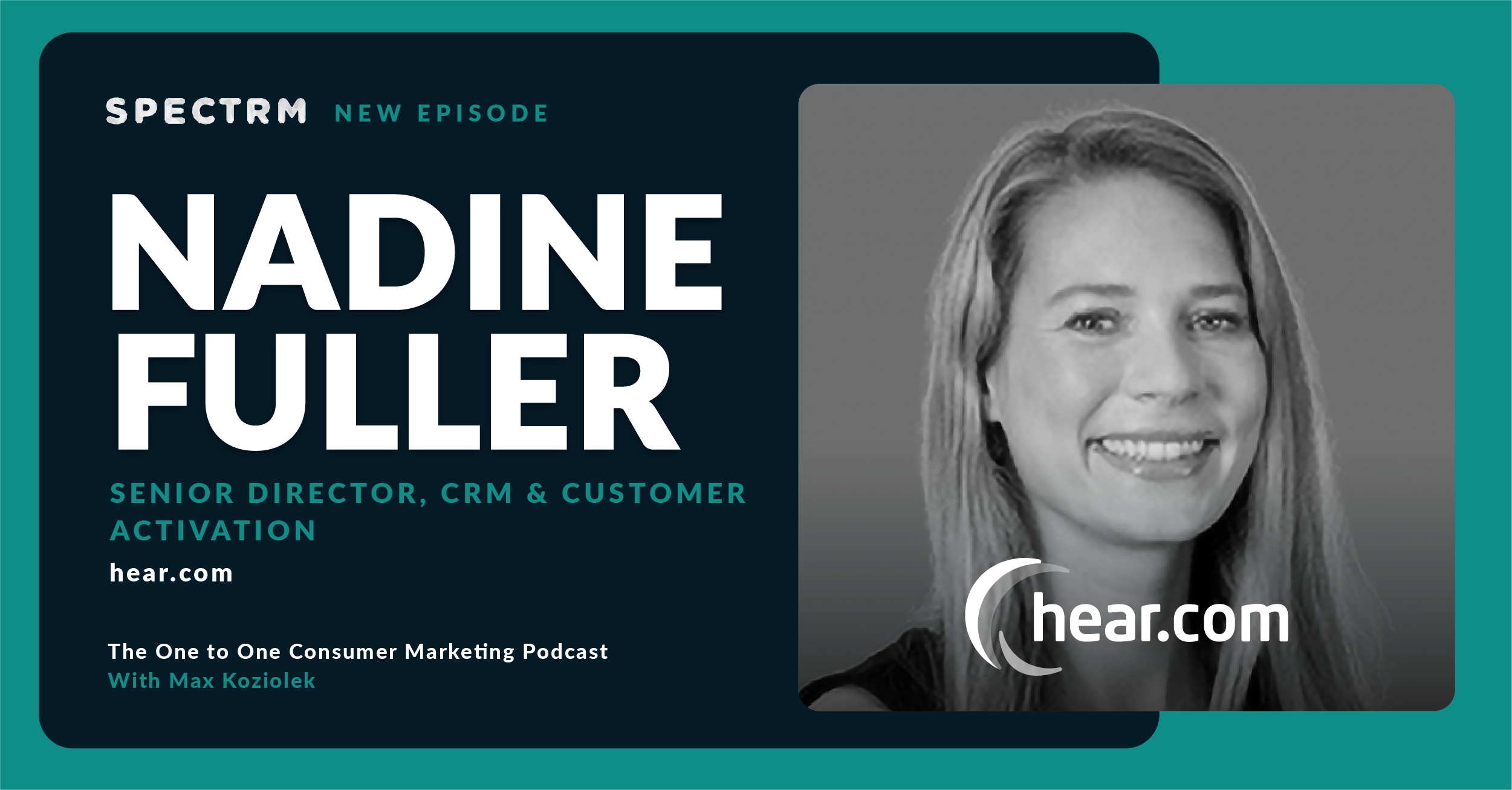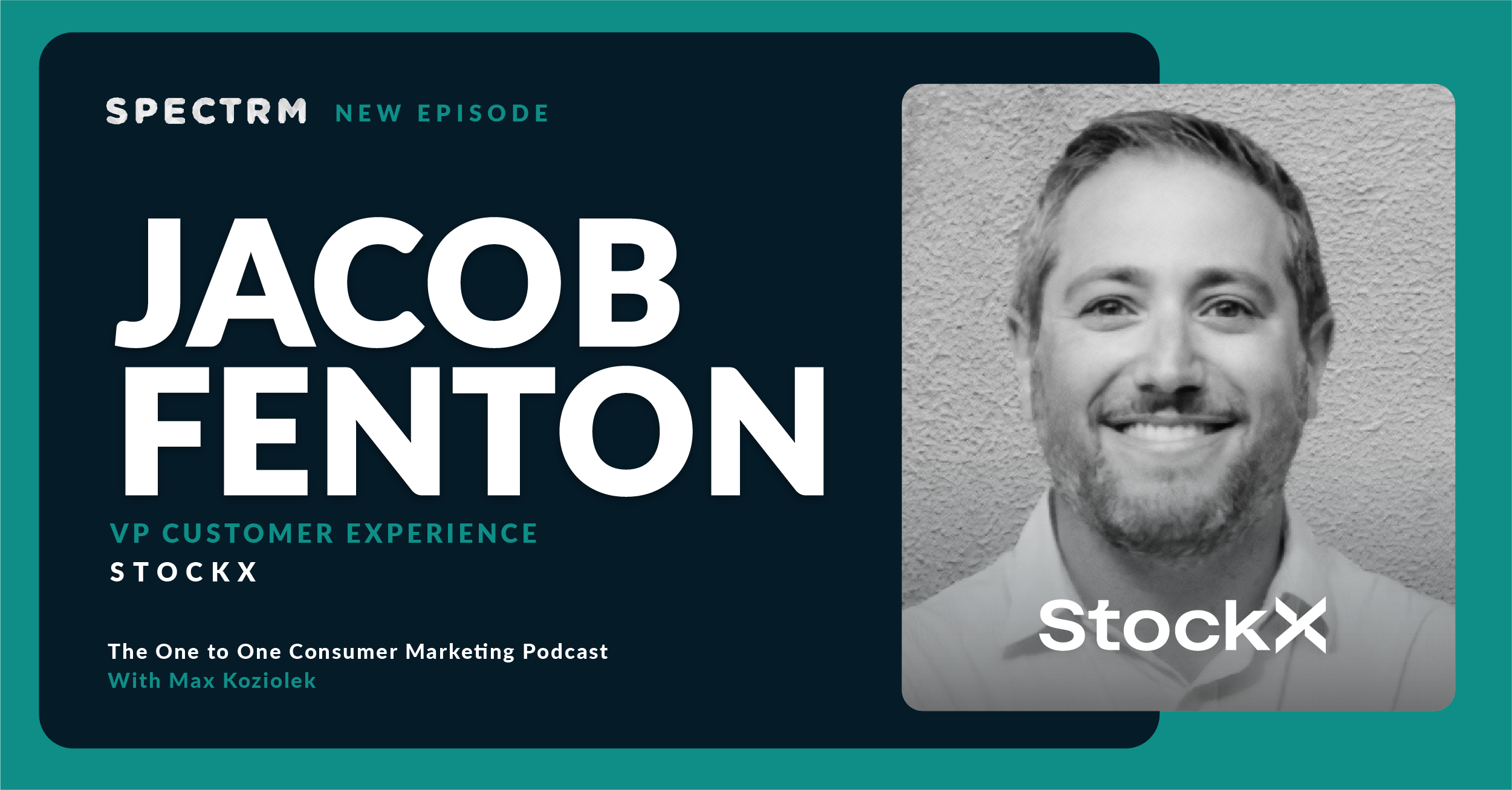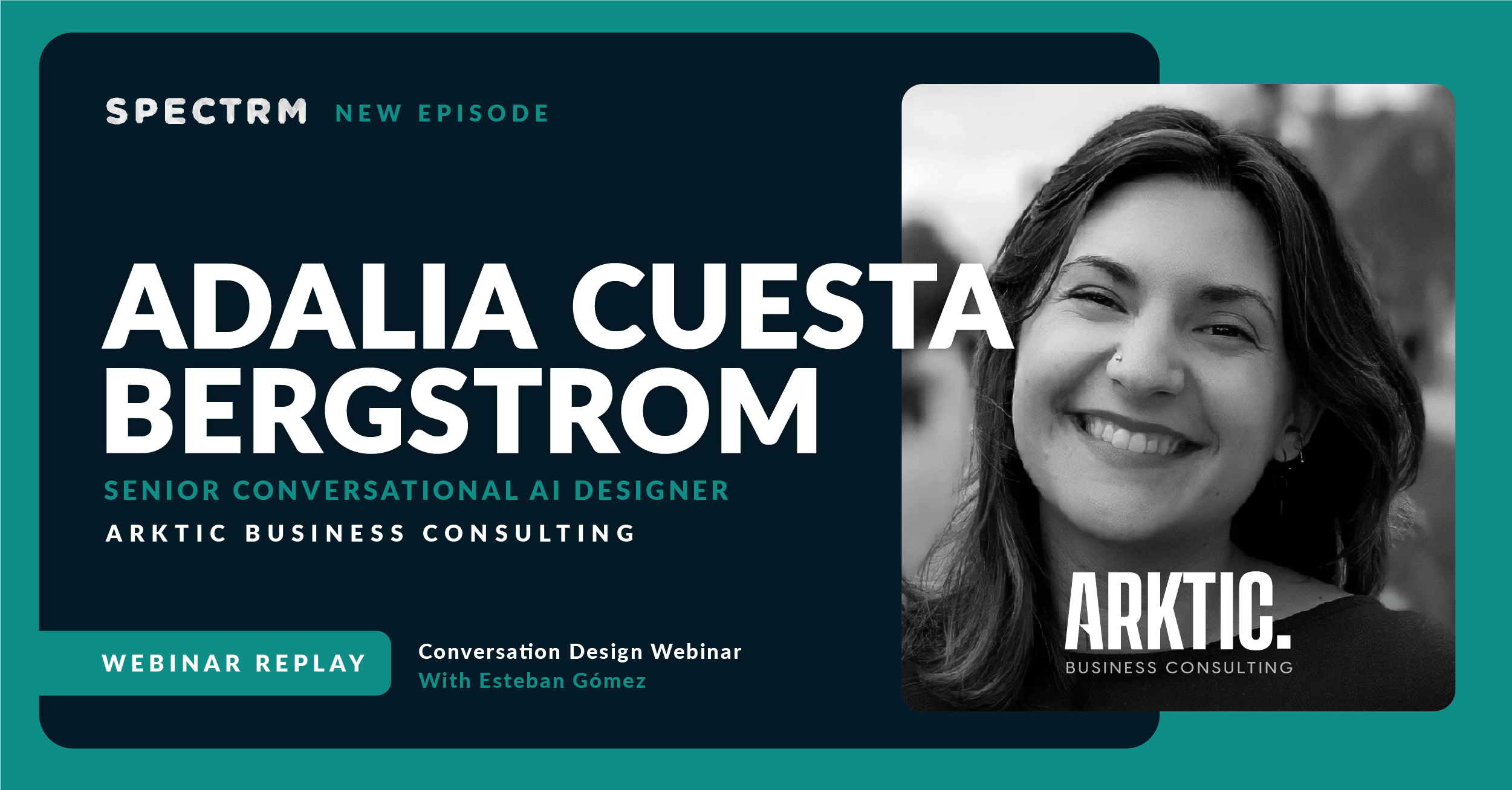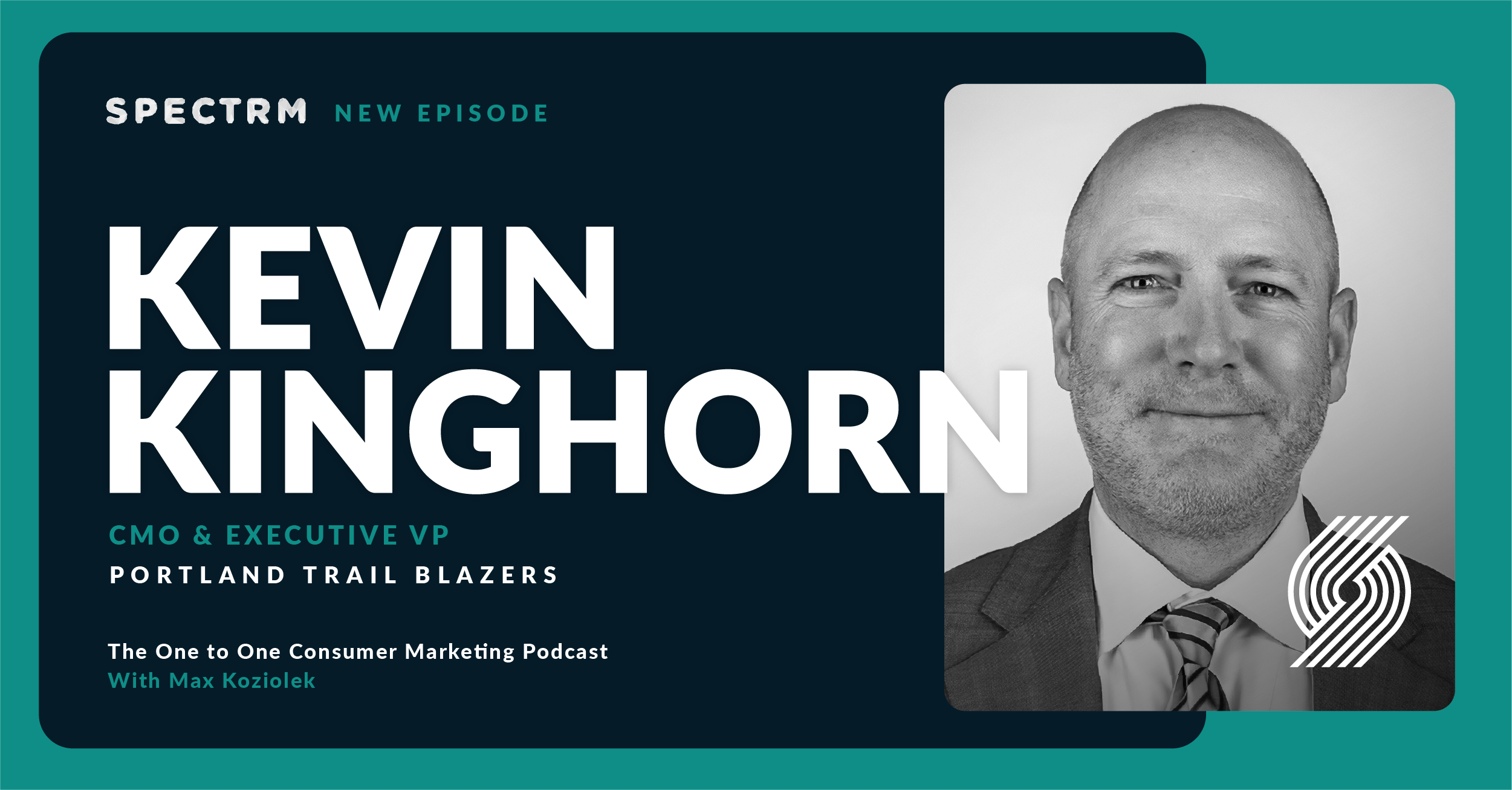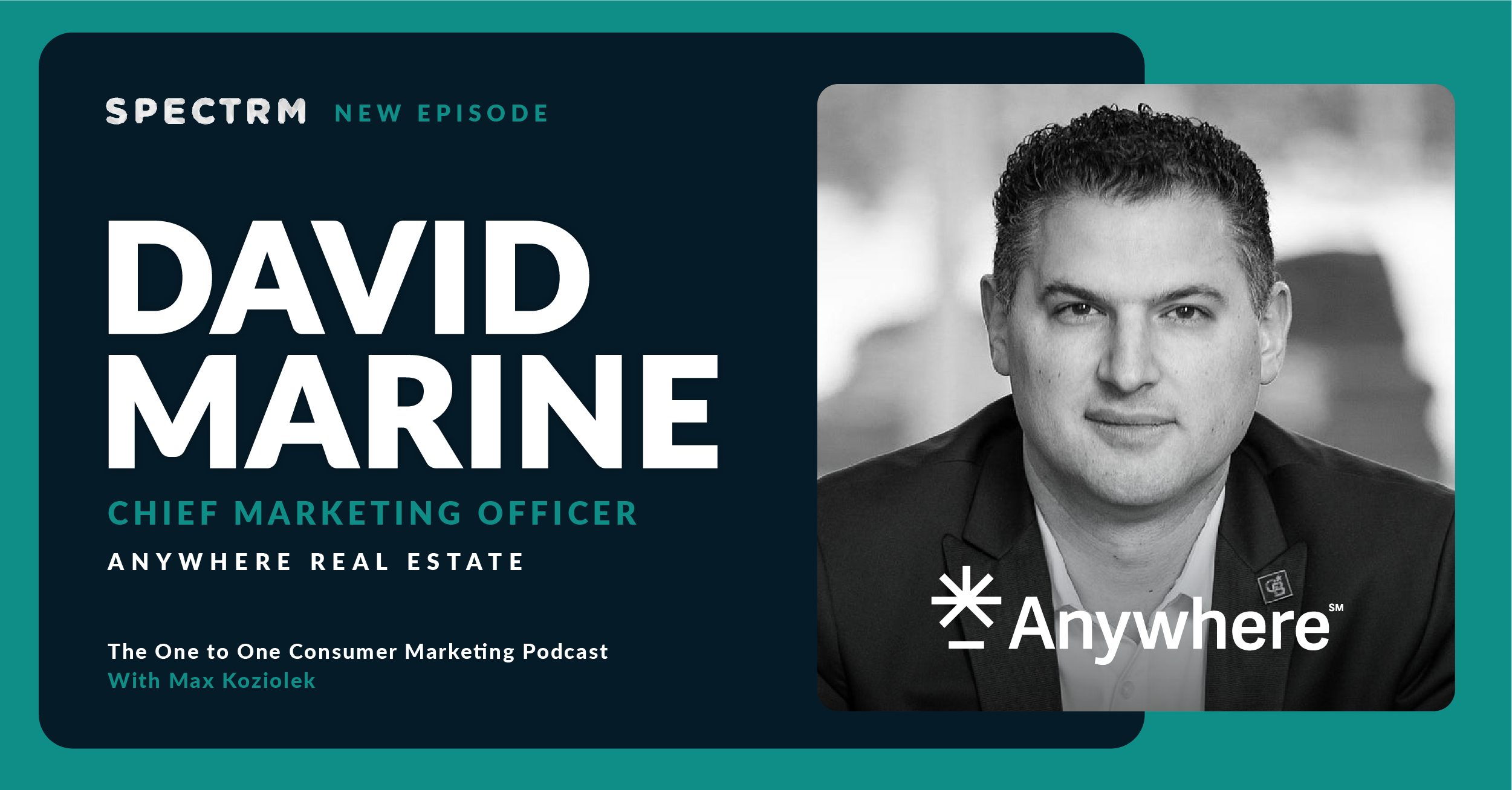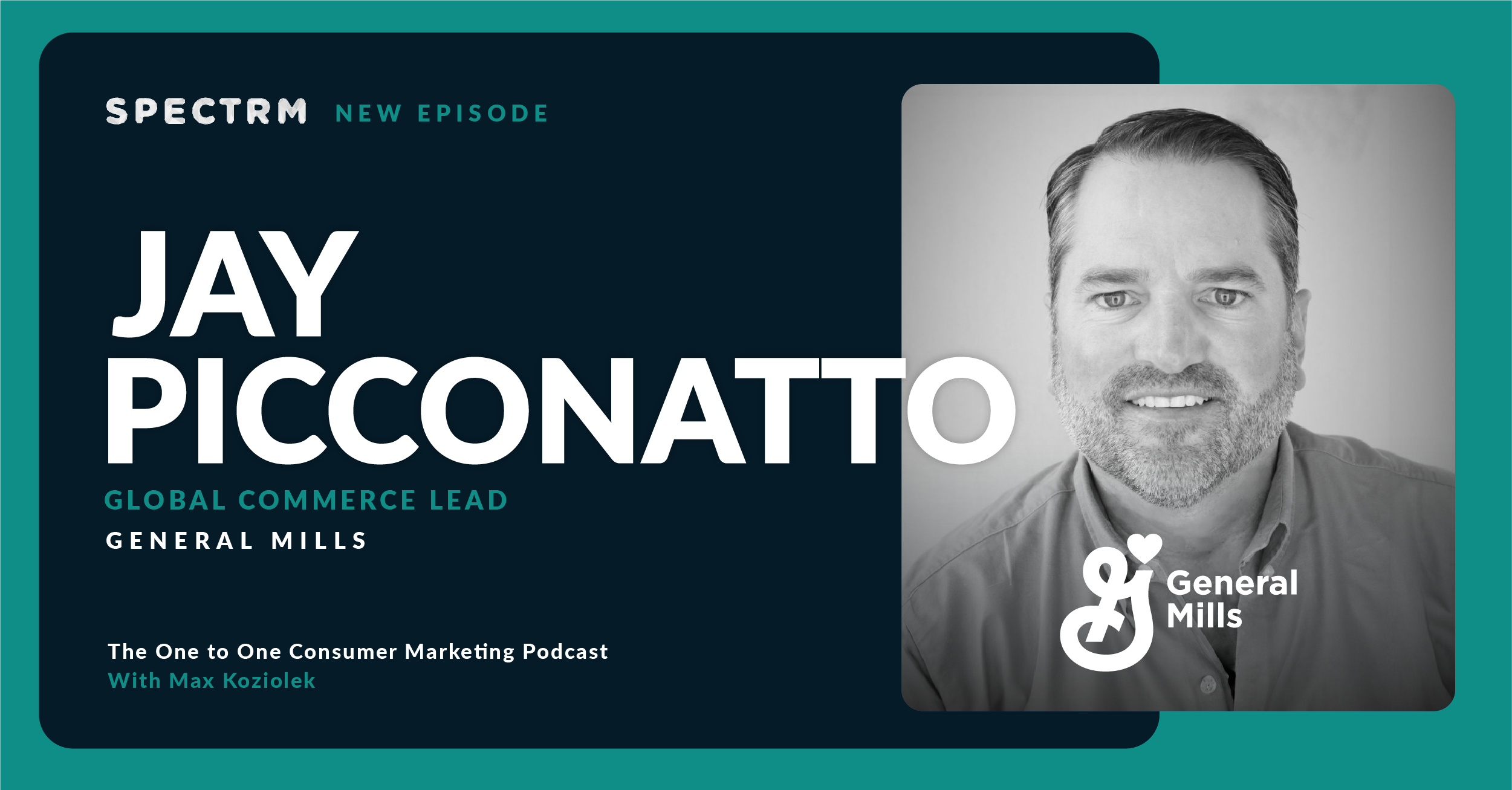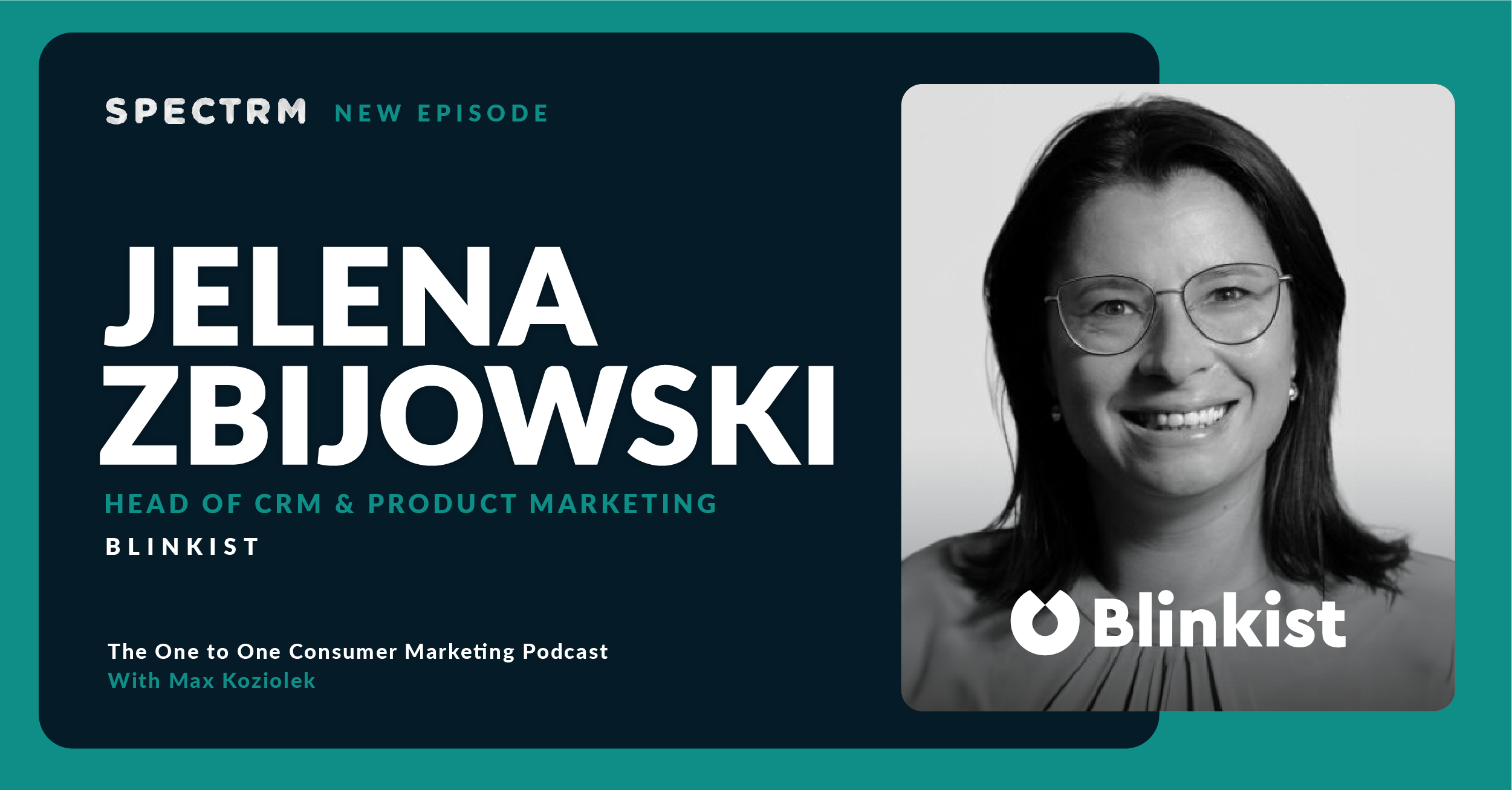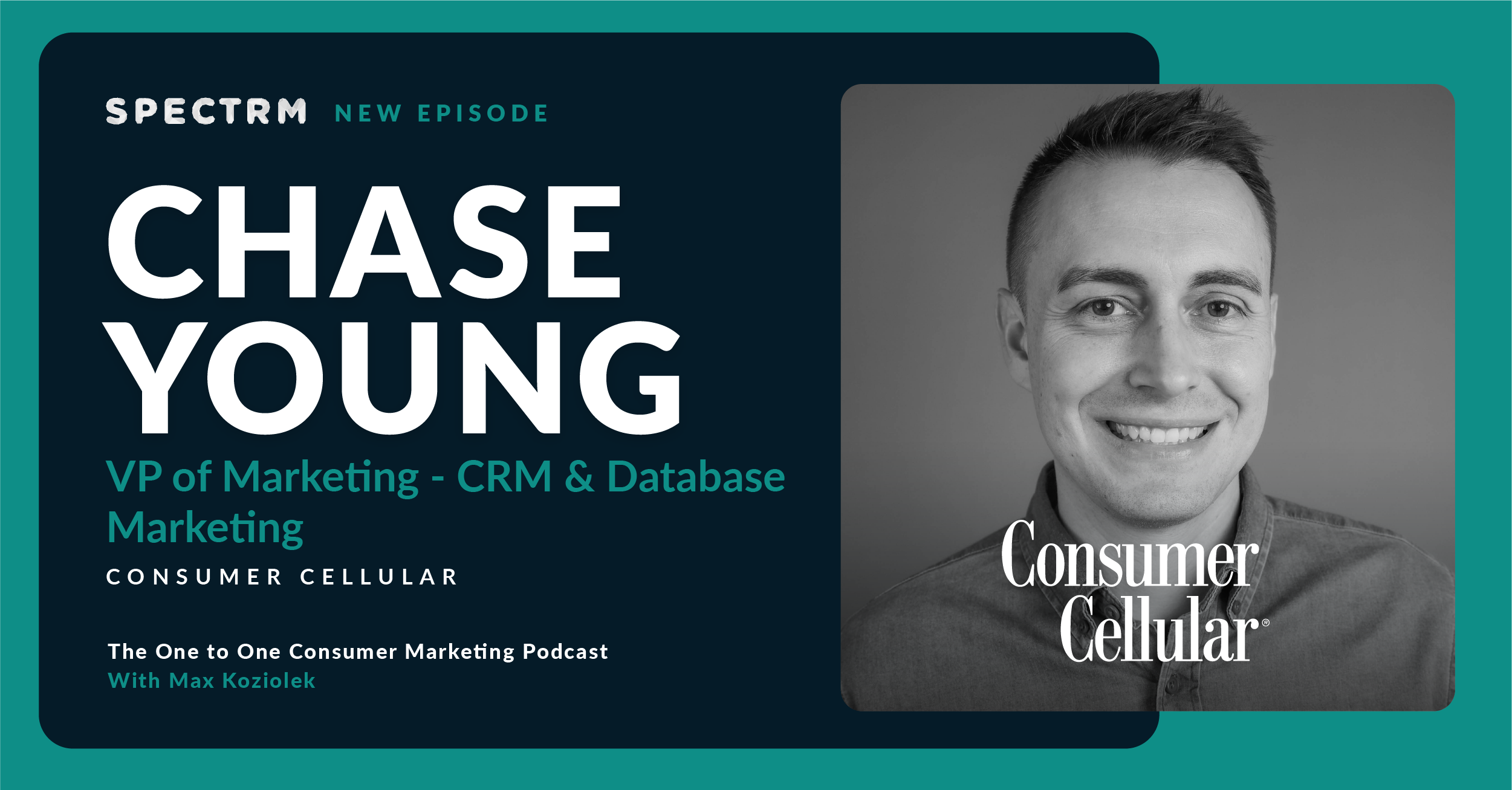Summary
On this episode of One-to-One Conversational Marketing, Ben speaks with Alanna Marder, Senior Director of Communications and Influencer Marketing at ColourPop, which is a line of products from Seed Beauty. Starting out in luxury fashion but feeling drawn to the less well-known brands because of their more agile and responsive market development strategies, Alanna now spends her time dominated by social media, figuring out innovative ways to optimize this ultra-interactive commercial space.
She speaks to us about what most people get wrong about influencer-led marketing strategies, why a traditional google spreadsheet remains her best option for keeping track of a growing client base, and why treating all your users like human beings is the best way to build authenticity for products and content alike. With community content at the heart of her approach, and a thoroughly engaged online presence, you can be sure to see ColourPop rising higher and faster than ever before in the next few years.
Topics discussed
- Why working for big name brands might not always be as rewarding as seeking out your own c-d brand partners to build something special together
- Why being close to customers and maintaining communications is absolutely critical for contemporary marketing
- Being a social media native brand, and the advantage that gives ColourPop in initial customer outreach
- How to manage a whole roster of influence with individual schedules and specific concerns, the power of a simple google spreadsheet
- How GRIN and Tribe Dynamics became the perfect tech stack for calculating the value of influencers to ColourPop’s brand
- Treating influencers with respect, and giving them some autonomy in the product promotion choices
- Giving influencers space to market their authenticity, but doing your homework and investigate who to trust
- Leveraging community content as the peak of authentic customer promotion
- Different engagement strategies for Facebook vs. TikTok, investing in conversations
- Why impressions score highest for ColourPop’s social media sales performance
Guest biography
We do a lot of listening to our customers and our community in the comments on social. We ask them a lot of questions. On the influencer front, we work with thousands of influencers, all of which we track them very closely. We know them by name, we know who’s performing, we know who’s missed posting, and we do that all by having some really old fashioned tools and some really new tools on how to track those people and make sure that we’re managing them appropriately and giving them what they need.

Alanna Marder
Senior Director of Communications and Influencer Marketing
SEED Beauty | ColourPop Cosmetics
- I am a communications and marketing expert with 10+ years of industry experience and expertise in brand storytelling, partnerships, strategy, event production, experiential, influencer marketing and public relations. I have had the fortune of honing my skills in New York, London and Los Angeles in sought after roles at companies including PR Consulting, Karla Otto, Aesop, FabFitFun, TechStyle and FORMA. My agency clients have included P&G Prestige, Coty Luxury, Gucci Beauty, Calvin Klein fragrances as well as luxury fashion houses such as Celine and Givenchy. I pride myself on my ability to excel at launching new brands and categories, or grow an existing brand or portfolio. I am a builder and an expander, and love working in a multidisciplinary environment with cross functional teams to achieve unprecedented success.
- I am a strategic thinker, dynamic producer, and a fantastic communicator. My favorite element of my career path is the ability to amplify the story, value and key selling points of the brands and companies I represent. I excel at defining a narrative and bringing it to life in unique and memorable ways, while prioritizing KPIs. I have a proven ability to establish new organizations, build teams, define strategy, develop innovative concepts, and drive project execution.
Company overview
With a unique combination of insight and foresight into the new world beauty landscape, we are the premier destination for acceleration in the beauty industry, bringing brands and products to consumers faster than anyone else in the world. SEED is reinventing how beauty brands interact with customers and are focused on turning beauty enthusiasts’ dreams into reality through continuous disruption.
Industry: personal care product manufacturing | www.seedbeauty.com
Subscribe to the podcast newsletter
Transcript
00:00
Welcome to One to One: The Conversational Marketing podcast dedicated to helping modern marketing teams succeed in a messaging first and privacy first world. In each episode, we’ll interview a marketer who is winning with conversational marketing to distill best practices, lessons learned, and actionable takeaways. Here’s your host, Ben Gibert, VP of Marketing, Spectrm.
00:33
Ben Gibert
Hey, everyone, and thanks for listening to One to One: The Conversational Marketing podcast. Today I’m speaking with Alanna Marder. She’s senior Director of Communications and Influencer Marketing at Color Pop, which is a line of products from Seed Beauty. Alanna, thanks for coming on the podcast and chatting with me today.
00:52
Alanna Marder
Thank you. It’s fun to virtually leave my little home office, but I never leave because some of us are still stuck at home.
00:58
Ben Gibert
I feel you. I am also here almost all the time as well. As I mentioned before, there’s often a little baby behind me that can scream. Just a heads up there, but it looks like you have a beautiful home office from what I’m seeing, which is nice. I think before, there’s a lot of interesting things we’re going to talk today about in terms of Color Pop, Instagram, Influencer Marketing, lots of good things when it comes to digital marketing in general. Before we do that, can you give a short intro to yourself, your background and what brought you eventually to Color Pop?
01:30
Alanna Marder
Yeah, so I’m originally from Canada and I’ve been in LA now for the past six odd years, I think, and I spend a lot of time in the intersection between communications influencer or celebrity relations and events and brand partnerships. I try to focus one and then somehow I’m focusing on all three or four very quickly again because they’re all so synergistic and tied together. I started out my career in more of the luxury fashion space. I spent a couple of years in New York, in London, and then I transitioned into the connection of fashion and beauty in the licensee space where I was working with licensee brands and their licensee fashion brands and their beauty segments. I found myself really interested in stepping away from these big fashion houses and big groups and being more in the day to day in D2C brands, where you’re able to see sales trends and really react to them.
02:22
Alanna Marder
For better or for worse, where you’re less protected by a big house or a big group, and you’re able to really make quick decisions and strategic pivots. Based on what happened last Tuesday. So I came out to LA. Kind of in search of that niche and spent some time in the subscription space for a couple of years and thankfully have found myself at Seed Beauty. I’ve been here for almost a year. As you mentioned, I lead our PR and communications function, our Influencer Marketing function, and then we don’t officially have an events team. So, like, I said, somehow it always becomes my job, which I love. That’s also a piece of kind of my purview.
02:59
Ben Gibert
Nice. Yeah. Thank you for that overview. It sounds like a lot of interesting experience. I’m sure as you mentioned, there’s a big difference between the kind of premium luxury houses and D2C, especially in the subscription space. I’m sure a big part of that, like you mentioned, is being agile, probably being a little closer to your customers as a marketer. Can you talk to that, how you feel you’re doing that at Color Pop and how you stay really close and kind of own that customer data and the relationship with them?
03:30
Alanna Marder
Yeah, it’s definitely an entirely different world in California B2C brands than it is in these New York or larger global fashion houses. Because I feel like there was, for me, a bit of a disconnect with your customer when I was in these bigger brands, because you see people on the street, like, carrying the purse that you’re marketing, or you see your flyers up on a billboard and you can see how it trickles down to the customer. You don’t really get customer feedback in the same way. You don’t kind of have listening tools where you’re able to listen to your customer in the way that you do in these kind of smaller, more D2C past feed stage of startup, but more growth oriented businesses. Color Pop has been really amazing for this piece of my career in terms of listening to customers, reacting to them, figuring out what we’re delivering and how it’s landing.
04:21
Alanna Marder
We do a ton of social listening. We’re a very social based brand, and because we kind of became who we are as a D2C brand who doesn’t really sell in retailers until recently besides Ulta, were built on social and were built with influencers, and were built on our own social accounts, and we have 10 million followers on Instagram. It’s a wildly engaged community, for better or for worse. We do a lot of listening to our customers and our community in the comments on social. We ask them a lot of questions. On the influencer front, we work with thousands of influencers, all of which we track them very closely. We know them by name, we know who’s performing, we know who’s missed posting, and we do that all by having some really old fashioned tools and some really new tools on how to track those people and make sure that we’re managing them appropriately and giving them what they need.
05:12
Alanna Marder
We also listen to the comments in our influencer posts and we listen really closely to what our influencers are saying. We kind of treat them as like an extension of our customer because they’re obviously the one speaking to our customer. I think the best long winded answer I’ll give you is we spend a lot of time on social in my world, listening and talking to our customers because that’s really our platform, that’s our tool, where we’ve been able to connect and grow in a really efficient way.
05:39
Ben Gibert
Yeah, 10 million followers. I know. I also recently saw that you started selling in Target, but clearly you have built a very strong brand and following on Instagram and like a lot of D2C brands, it seems to be that has been like your trajectory for growth. I’d love to dig in into the tools. You mentioned you’re using a combination of new and old school tools. When you say old school, I’m just imagining a Google Sheet or an Excel Sheet with all your influencer list. What other kind of things are in your stack that help you manage all those relationships to really make the most of influencers you’re working with?
06:12
Alanna Marder
Yeah, so as much as we tried to get away from it, we keep coming back to kind of an old fashioned version of a Google Sheet for some of our management. I think that’s because we launch really frequently and so with a really robust community, we have really large group of influencers that we work with. With how often we launch, we want to make sure that we’re not sending everybody the same items that they got, like last month and that we’re alternating and that everybody gets a piece of the pie. We’ve tried a lot of different things and we keep coming back to our good old fashioned Google Sheets to be able to organize that and sort it. Beyond that, two of the platforms on the influencer side that we use are Tribe Dynamics and Grin. A lot of people use those together and a lot of people use them apart and think we’re ridiculous for using them together.
06:58
Alanna Marder
I think one of the reasons that we came to Grin is for organization and community management and we actually ended up using them in a very different way than we planned to. And it’s been a really pleasant surprise. We use them to allow our influencer community to place orders via our website because they’re integrated with shopify. That for us, when we first signed up, was like a benefit. It was just like a hot ticket and were like, that’s a cool extra thing that we can do. We’re going to primarily use Grin for different functionalities. And we really got in it. We realized how valuable this was and this became our big focus because we launched the Munch and we have so many influencers and the influencer landscape has changed in such a big way with every brand sending every influencer so much stuff. We don’t want to just be like flinging packages out the door.
07:46
Alanna Marder
It’s not respectful to the environment, it’s not respectful to our influencer, it’s not respectful to our customer, and it’s not respectful to our budget. It’s just not a good plan anymore. We use Grin to allow a rotating group of our influencers to order from our website and to shop custom collections that we create for them based on what we’re focused on, based on what we’re pushing, whether it’s cyber, whether it’s gifting season, whether it’s Halloween. That for us has kind of widened our breath and allowed us to interact with more influencers every month. Because it doesn’t mean that in order to interact with 1000 more influencers we have to send a thousand more packages. We can send out a thousand emails and they can all feel like they heard from us and they were offered something from us. If they need something from us, they have a very accessible way to get it and 30% to 60% of those people will respond and place an order and then we have product in their hands.
08:41
Alanna Marder
We didn’t waste money on the other 40% that were traveling or weren’t interested or had enough, which is definitely important during today’s overwhelm world. We use Tribe for more of our tracking purposes in the beauty space. Tribe is kind of a leader in ranking different brands in terms of how much EMV you’re receiving and EMV in terms of earned media value. That’s really a proprietary metric that multiple different tracking softwares have and they’re all different. Tribes is however Tribe calculates it and it’s a combination of impressions, engagements, views, likes, comments, et cetera. They all hold a different weighting and they all shift as the new algorithms shift, although we’re doing our best to keep up with how fast they are shifting. We use Tribe to really understand who is driving what awareness, who is posting right now, who is posting the posts that are getting the most likes and getting the most views, and how do we make sure we interact with those people and keep them engaged.
09:43
Alanna Marder
Also, how do we see those posts really quickly so that we can engage with them and so that we can make sure we’re trolling the comments and answering questions if needed. Our social team that is responsible for building that group of 10 million engaged, amazing people supports us in hopping in and seeing who’s posted and how can we hop into those comments to support our KPIs and goals. It also allows us to look at who haven’t we heard from in a while, like who have we sent packages to and reached out to and they’ve kind of gone dormant. And why have they gone dormant? Have they stopped posting all brands altogether? Have they just stopped posting us? It allows us to kind of prioritize where we focus our energy and efforts and start to really learn people’s faces and names beyond just being like a name on a spreadsheet because community is so important to us.
10:29
Alanna Marder
We don’t want any of our influencers to just feel like they’re a name on a spreadsheet and we’re sending them a package. They’re a human being and they’re supporting us and we want to support them. Tribe allows us to kind of identify them as a top earner, top performer, top poster, or somebody who’s fallen off or somebody who sits in the middle or somebody who’s posted about a competitor brand and they’ve jumped out at us. It’s a really helpful tracking software for us in all of those different ways.
10:58
Ben Gibert
Yeah, I love that. Thank you for the very detailed breakdown. It’s the kind of thing that’s so interesting to our listeners and I think to digital marketers that are trying to use influencer networks like that. It seems like you have a very detailed approach to that in the sense that you’re operating at such a scale that it’s almost like you’re treating them like the customers as well. Right. There’s an entire order management system that you’ve built out to serve them to make sure that they get the level of personalization that you would almost expect a lot of customers to be getting. I think it’s really interesting also how you’ve found a tool that had such a key feature for you that you wouldn’t have considered as a major benefit, but that became kind of the foundation for how you’re actually able to scale this out, really, I think really interesting to see how that’s worked.
11:41
Ben Gibert
I mean, I’ve talked to quite a few people on this podcast who talk about influencer and community marketing and allowing your brands to kind of run wild in culture and on social. How do you view that? Do you like to keep things relatively controlled in terms of the influencers that you are working with? I mean, you work with so many that there must be some complexity in that. I’d love to hear your thoughts on do you try to keep the brand very tight? Do you let influencers kind of run with it? What are your feelings on that?
12:12
Alanna Marder
That’s such an interesting question because I’m such a control freak in so many aspects of my life and I actually don’t believe that controlling our community and the message to a very finite degree is beneficial anymore. I think influencer marketing, there was a time where the space was less noisy, there were less influencers, there were less creators, especially before TikTok happened and made your neighbor famous and great for your neighbor. That’s just not the creators that built influencer marketing. There was a time where making sure that influencer said exactly what you wanted them to say was really important because that’s how people were used to being given information and receiving quote unquote ads and there was more validity from the customer perspective. Like if you saw somebody promoting something and you trusted them as an influencer as a creator. You trusted what they were selling, and you felt like they were doing it because it was important to them and you could relate to them.
13:13
Alanna Marder
There’s been so much growth with influencers over the past six months, two years, five years, that now a lot of those influencers aren’t relatable to the customer anymore. Now people are like, well, how can you used to have a job, you used to work at a supermarket. I used to work at Macy’s. I got you before. You just felt like I was following my friend. Now you live in a mansion and you’re in Italy all the time. I don’t get you anymore. I want to know what you’re doing, but I can’t afford what you’re talking about, and it feels like you’re reading me a script. TikTok has given way to this very organic type of creator and influencer that, like I said, it could be your neighbor, it could be your kid is all of a sudden famous because they’re posting fun dances on. TikTok, which is scary, but also wild for the people who are on my side of the table because there’s a whole new subset of talent that we’re speaking to.
14:04
Alanna Marder
The reason that talent exists is because they’re authentic, and they’re talking about what matters to them, and they feel really real. I think the biggest and most meaningful thing in the influencer marketing space is making sure that you’re thinking about your customer as the final customer, spending the money, but also your influencer . You’re making them feel like they get to lean into what works for their audience. Because if you allow them to do that, I’m giving away what I feel like is a big internal secret here. If you allow them to do that, I feel like you’re often able to spend a little less. I hope no influencers are listening to this, but it’s because you’re not requiring them to stand there and recite exactly what you wrote for them. You’re giving them an opportunity to create content that they feel like will resonate, could go viral.
14:55
Alanna Marder
You may put ad spend behind, and you’re letting them do it with their own personality in it, and you’re not having them read your script verbatim and do exactly what you told them to do, which is going to get a good response for them. At the end of the day, the customer that’s watching them, which is their customer, and our customer, hopefully, is feeling like it’s real and is really feeling like they can believe what that influencer is saying, and they want to believe what they’re saying because it doesn’t feel forced. There’s so much more potential for virality, there’s so much more potential for sales. There’s so much more potential for consumer conversion when you don’t control things too hard because it just feels inauthentic. The one contradictory thing that I’ll say is that it’s important to not let your brand message get run away with and you want to make sure that you’re working with the right type of influencer who’s not going to misrepresent who you are and working with an influencer that doesn’t stand for your values.
15:52
Alanna Marder
Cancel culture is a big thing, and no one should walk around being afraid of cancel culture, but they should walk around with the awareness of you need to really investigate who you work with and make sure that they’re the right people. If they’re the wrong people, take responsibility for it and address it and correct it. That’s the one piece that I would say to control is, like, make sure you’re working with the people that you can trust to tell the right story about your brand, even if it’s their version of the story. A story that you feel aligned with so that you’re not aligning yourself with views that might not be appropriate for your target customer or your existing customer.
16:30
Ben Gibert
Yeah. I love that you have to, like you said, control that to some extent, but then for it to feel authentic to their communities, it’s about letting them retell your story in a way that makes it their story, which is how eventually that trickles down into making it the person, the customer story on the receiving end of it, too. They can then connect with that person. I also totally agree with you that the disconnect from the huge influencers on Instagram and the type of lives that they have started leading versus what’s happening on TikTok, it’s a very different world. I feel like everyone talks about Gen Z in particular, seeking authenticity, shifting away from the picture of the perfect life and wanting something that feels more real and a bit more raw. I’m sure that you’ve seen a lot of that with the people that you’re working with.
17:15
Ben Gibert
I think TikTok is also just the nature of you mentioned sometimes promoting the content like influencer content through ads. I feel like TikTok is such a good platform for that because it feels so native and in stream even when you are promoting it like sponsored content, there is just incredibly native feeling to the experience of scrolling through a video. I think it probably has a lot of power there too.
17:39
Alanna Marder
Yeah, I mean, TikTok has made a great choice by making advertisements feel like native organic content and I think meta has gone the opposite direction and it’s created a big divide. I think one of the things just to piggyback off something you said, one of the things that we actually do that I hope influencers are listening for is we go search for content that we think is great, that they’ve created unbeknownst to us, whether it’s that they purchased an item or they were gifted an item. If it’s content that we feel like speaks very clearly to something we’re focused on. We’ll ask them to purchase ad rights to it, and then we’ll then run ads behind that content. We look to our community that’s generating organic content to then pay them after they’ve created something and actually boost those ads, because that’s the most authentic ad you could possibly make, is something that someone made.
18:32
Alanna Marder
You didn’t ask them to make it. They said something that was so true to who you are that you want to now use it as an ad.
18:38
Ben Gibert
Yeah, that’s amazing. I wish I had that kind of thing in the B2B space. It rarely happens, but I’m sure you have a wealth of amazing kind of community generated content like that, and that’s such a good shout out. I mean, I think that we’ve touched on a couple of the things as far as how you see the state of consumer and influencer marketing today in terms of those shifts. If you were to give kind of a lay of the land and what you see as the most interesting things, what are they for you?
19:07
Alanna Marder
I think one of the biggest challenges and interesting things, and I don’t know where this goes, is just Meta is playing around with algorithms and changing so many systems and functions, and there’s so many privacy functions via Apple which are very important to change. I respect and appreciate those changes. As a customer, as a marketer, makes my job harder. As a customer, they’re important and they’re there for a reason. I think this ever evolving social landscape is moving so fast that it makes me wonder how this is completely unsustainable, like how fast we’re moving and what comes next. I don’t know the answer, but I think in terms of keeping up with how fast we’re going and what comes next, it’s pretty wild. I think one of the things that’s really interesting is Meta’s new rollout of subscriptions on Instagram. You’re able to subscribe to a creator channel or a brand channel.
20:02
Alanna Marder
I think that’s fascinating, and I think it’s really fascinating for brands, I think for creators. I think it causes a whole slew of things that I haven’t even got to yet on the sponsorship side or the gifting side. I’m really curious to see where that goes. I think Meta has a lot of great things that they’re working on like this. I do think a lot about how sustainable how all of this fast moving growth is and how sustainable it is to have just such a massive group of creators and influencers out there. That’s only fueled by how many more social media platforms we’re getting. It’s become like a job now that people, young people, aspire to be like, I want to be a YouTube creator. What does that mean when ten years from now, when they’re 20 years old? I try not to think about it too hard because it breaks my brain.
20:49
Alanna Marder
That’s something we talk about all the time.
20:53
Ben Gibert
Yeah, I believe it’s. I think that’s the reality that digital marketers have to grapple with is just ever evolving and probably shifting faster and faster like you said. I think that evolution of influencers and creators as well is one that I’m watching with curiosity because you see it on every social network. Just the sheer volume of people that are getting into the game because of the money that’s in the game as well. Now, it’s fascinating to watch and I think it’s going to be interesting to watch the evolution of communities and influencers that have been there for so long. An influencer that becomes an influencer when they’re 1820. What does that look like when they’re 30? If they continue with that, right? Is that a job they can sustain? How does the types of influence they have, the communities they have influence over, evolve? Yeah, very interesting space.
21:43
Ben Gibert
I personally am not so deep in the influencer marketing side of things. It’s very interesting to hear you talk through how you see the market because obviously Color Pop has used this as the foundation for so much of its growth, which has been very explosive. I mean, I’d love to shift . We’ve talked about instagram TikTok. You mentioned at the very start that Color Pop has even gone into some retail and obviously Target is like a huge partnership. What channels are you seeing work best and what about the least? Another thing you touched on is also privacy. Like the reduction of signals that we have as digital marketers to reach the right people with the right message and to really understand what’s going on in our funnel here. You talk through what channels are working.
22:25
Alanna Marder
For you for sure. I think I can’t necessarily speak to numbers per se. We also just launched in Target like eleven days and counting ago. What I will say, which I think D2C is really challenging now and it’s because there’s so many startups and there’s so many young brands and the beauty space has gotten really saturated and D2C has always been our bread and butter. It’s always done really well for us. People know us as like Colorpop.com. We’ve never had a physical location. We’ve done partnerships with retail stores before. We’ve been physically accessible via Ulta and Sephora in the past. People know our website is our Spot and our Instagram and our social is how they get the content and the information. That being said, I think there is a lot of interest from the customer now, especially after COVID to try things in person and to be less challenged by a return process or with supply chain issues to have to wait for something to ship.
23:25
Alanna Marder
People really want instant gratification in a big way. Although you walk around the streets of New York and all of the stores are empty and it’s really eerie and you feel like, where are all the shoppers? D2C is making up? I’m not speaking on behalf of color problems. Speaking up, like larger conversations that I’ve had recently online, is making up a small percentage. For us that’s D2C because we don’t have an in person store, but for brands that have in person stores.com is still only making up a small percentage of the business that they’re doing. So Target was really great for us. It was really exciting because were able to be accessible. Accessible is so important and.com doesn’t necessarily mean the most accessible thing anymore, especially if you’re not on Amazon and you can’t be in someone’s hands in 24 hours.
24:11
Alanna Marder
I would say accessibility is something that’s a massive focus for our customers right now and it’s a big focus for us in response. On the advertising front, I’m going to kind of speak separate to color pop here, but I think two things that do really well for us, or a couple of things. One is like working with affiliate partners and making sure that we’re talking to our customers in a way that they can hear us with deals that make sense for them. We have a really amazing guy who leads our affiliate channel and he’s really great at finding those things. I think it works on me all the time. Like, I get a honey pop up and I’m like, oh, I get $2 off, I’m going to buy this. I didn’t need that thing. They’re speaking to me in the moment of what matters and Immediacy is important.
24:51
Alanna Marder
Working with affiliate partners to reach those people who react to those types offers that wouldn’t react to them if they just, I don’t know, got a text message at 08:00 in the morning when they were busy or got an email. They probably just filed an email because it’s in their spam folder of Google. Affiliate partners have been a really big and great resource for us. It’s obviously a challenge for our Omnichannel because we can’t run that for Omni, we can only run it for D2 C, but it’s something that’s been great. On the ad front, not to take it back to social. Strangely enough, I think Facebook and TikTok are the two that tend to work. Because Facebook, you’re talking to a really engaged group of people who usually are older, or they’re there to go on a forum and talk to each other and be in a group and communicate and really get feedback and responses.
25:40
Alanna Marder
TikTok just feels so organic that people aren’t like, oh, this is an ad I’m going to scroll, which is I’m sure not always going to exist. Many of my marketing friends are like, I feel like we’re. In this cash grab moment and we just need to stay in it for as long as we can. A couple of things that I’m interested in the ad space that I haven’t really gotten into in a big way yet is Reddit. There was a really interesting article recently about beauty and reddit and authenticity is so important. Real people’s opinions are so important. I think as we zoom out and think about where we invest our time and energy, investing in the real people and the real conversations is something that’s going to work really well for advertising over the next little while because Instagram, the feedback from everyone is it feels too curated.
26:25
Alanna Marder
I don’t like being served ads all the time. I don’t like feeling like I’m scrolling through some version of a magazine with my friends faces on it that don’t even feel like my friends anymore because it’s like, when did they become an Instagram model? I’m really curious to see how Reddit and other relevant platforms become something that we focus on in a way that maybe we didn’t used to.
26:45
Ben Gibert
Yeah, you mentioned some really good collection of channels there. I feel like so many D2C brands that were born of social and that relationship that was so online and direct to consumer have obviously then cemented big retail partnerships like Target to continue to scale their growth or moved into stores, which was kind of the antithesis of what they were doing in the first place. That’s obviously a natural evolution of trying to grow revenue in the space. I think the lens that you put there is really interesting, right, accessibility. It’s not like I feel like your investments on Social, whether they’re, TikTok, Instagram, Reddit will pour over into that space, right? Like people will know your brand, they will go into Target, they will be able to buy color, pop directly and test it. I think there will be probably a knock on effect that you’re not going to see in your campaign, your Attribution tools or anything like that, but it will be there.
27:38
Ben Gibert
I think Reddit also interesting one where it’s, again, like you said, it boils down to authenticity. Like the people that are on threads in Reddit are very deep into a topic and they value each other’s kind of input. I think that’s a really interesting community because it’s also very different. The dynamics are very different to some of the other ones you laid out.
27:58
Alanna Marder
The dynamics are a little scary on Reddit, but I was talking to somebody the other day and they were talking about they’re an Omnichannel brand and they were talking about how their advertising programs for D2C and Omnichannel were completely separate and their influencer programs were completely separate. I was really pushing them on why that is. Because everything you do for D2C will waterfall over to CVS, Target, Whole Foods wherever you’re selling Ulta, Sephora because it’s so much about brand awareness and you now can’t track someone’s clickability like they’ve gone and they’ve seen you in Target when they’re buying their bananas or their kids clothes and they’re like, oh, I don’t need to go to a website and order my mascara. I’m just going to grab this one. I’ve heard it’s good. You’ve all of a sudden just hooked a new customer.
28:54
Alanna Marder
You would never know that because you can’t track it to your.com so I think it’s so important in the influencer and PR space to be able to zoom out as a business and say, what are my KPIs here? Beyond conversions? Because influencers and media don’t sell like they used to because not everything is just.com and they’re not driving clicks like they used to. People are interacting so differently that if you make your singular KPI sales, you’re going to constantly feel like you’re on a hamster wheel. You have to be able to zoom out, look at the big picture, look at the data and start to identify trends. One of the things we looked at is besides this EMV metric that we go by, that is Tribes metric, what other numbers most highly correlate to our sales performance? Is it reach? Is it number of posts?
29:43
Alanna Marder
Is it numbers of influencers posting? We found out that answer and then that’s what our secondary goal is. We want, for example, impressions to be we care about impressions the most because that’s where we see our sales trend the highest across all of our platforms. That’s what you really need to be thinking about because if you are like, how many lift glosses did that Vogue article sell? The answer is two, you never want to do that again, but of course you want to do that again.
30:12
Ben Gibert
Yeah, that’s such a good point. We’ve seen that with a lot of the brands that we work with as well, that the ones there has been this shift, right, like the beginning of ecomm or just online retail in general was everything was optimized towards the most downstream conversion possible, right? We only care about sales. We care about the highest average order value. I think the space is maturing and people are seeing that actually the way that people buy now is so different, like you said. It’s interesting to hear you talk about how do we correlate the different metrics further upstream to sales without necessarily having like a last click or direct relationship. I mean, it’s obviously not a brand new thing, is lots of big brands that have been doing this for a long time online. I think that narrative is becoming more and more commonplace.
30:55
Ben Gibert
Like people are waking up to the reality that you’re not going to be able to track everything perfectly in your campaign manager and you’re probably going to make some very poor decisions like you outlined about Vogue. If you are solely looking at those metrics, when really if you take a more holistic view of it, you can make decisions that are much better for your business in the long term.
31:14
Alanna Marder
Yeah, if I could shout something into the void and just pray that it stuck, it would be like any human being in any brand marketing role needs to have the ability to do their work attributed to brand marketing metrics and not just like conversion or financial metrics because it’s so important. I think when you go into a business and you’re not aligned on that and maybe your financial leadership doesn’t agree with that, you’re not set up for success. Your business is most likely not going to be as successful as it could because you’re not allowing yourself the space for awareness and recognition and brand allegiance for new customers and old customers. When I am looking at opportunities, whether it’s on the consulting side or whether it’s when I came to Color Pop, that was the first conversation I had is, what are your KPIs like?
32:07
Alanna Marder
What do you want to see from someone like me? It was so refreshing to have the conversation about, yes, of course sales are important to us, site sessions are important to us, that’s our ultimate goal is to financially do well and move our product and get our product in people’s hands and have them love it. Along the way, we know that our metrics are going to be brand awareness focused at least some of the time. When I’m meeting with someone in the consult thing front and they’re like, well wait, how much is that going to sell? I just usually end up saying, I don’t think I’m the right fit for you and I don’t think you’re the right fit for me because I don’t want to let you down and I don’t know anyone that’s not going to let you down.
32:43
Ben Gibert
Yeah, a good thing to get straight at the very beginning of that relationship, for sure. Look, there are some questions that we had that we don’t have so much time to cover because I think some of the things that we’ve talked about are way more interesting and a bit more detailed than the initial questions we had in this. No, not at all. This is great and I’d love to wrap things up but also focus on maybe the top three pieces of advice that you would have for other marketers in this space. You’ve touched on a bunch of things here, but if you could just give three, what would they be?
33:15
Alanna Marder
I think the first is kind of what I just said about that I’d love to shout into the void is allow yourself the space to grow and do the exercises that you need to really make your customers know who you are and what you stand for and stand out against the competition because there is so much competition now. Allow your KPIs to also be awareness focused as long as you’re in the right function to be able to do that. I think the second piece I would say is really find ways to listen to your customer, whether it’s like spending time on social each day, whether it’s looking at your influencer comments, whether it’s having a social listening tool and really utilizing that tool. If you don’t have the time for any of those things, find a way to download a report that shows you sentiment and really flag like the top.
33:57
Alanna Marder
Interacted with comments because you’ll learn so much from the people that are spending time giving you information and hold hands with your CS team. Like the amount of CS emails I’m in, I sometimes I’m like, Why? Why? I learn a lot and, it waterfalls over into how I speak and what I do and decide to do. I think the other this is off topic from everything we just spoke about, but people and amazing people are really harD2Come by on a team and in a working environment. I think investing in your team and the people that you work with just as much as you invest in your customer are really important because those are the people that are going to keep your business moving and running. Making sure that your team has what they need in order to succeed is the first and most important thing in order to set up like a successful function in business.
34:44
Alanna Marder
We’re all at home and we’re not sitting near each other anymore and we’re not giving the younger subset the opportunities we had to hear each other talk. It’s easy to forget how important those people are, but just really invest in your team in the best way how. If it’s not however it is, it’s just important to remember that they’re the first link to your customer. You got to invest in the people in your own room and in your own company.
35:09
Ben Gibert
Yeah, I love that. Investing in your team a very big one, and I’d say the other one. Like, competition is fierce, so awareness is key. Like you said, number one, awareness is key. Number two, know your customers because that’s how you’re going to win your market. You’re going to win your market by having an amazing team of people that are going to help you do that as well. I think those are great pieces of advice for any marketer out there as we wrap up. I know you said you don’t like to project too much into the future. You don’t know what’s coming. Five years from now, can you give a guess? Like, what do you feel? What is the future of consumer marketing looking like?
35:44
Alanna Marder
We’re all going to live on the moon at that point, I think that the Gen Z generation is even more defensive or protective, I should say. That’s a more appropriate word of their privacy and of what they’ll let into their space and what brands that they’ll continue to pay for and partner with. I think things like text messages, things like pop up ads, like subscribing to emails, I think those are going to become a lot less prevalent because someone who’s much younger than me just showed me how to unsubscribe from all my emails by clicking one button and I was like, what just happened? I think we’re going to have to reach Gen Z and the more evolved private customer in ways that are different than we’re used to. It’s not going to be SMS, it’s not going to be email, it’s not going to be banner ads.
36:30
Alanna Marder
We’re going to have to find ways that are more meaningful. I think part of that is like business ethos, philanthropy, who we partner with, how we tell stories, where we show up. I think it’s going to be a lot of more meaningful marketing work versus just communicating, which is what we do now, is we communicate all day long to everybody all the time. So we’ll see. But that’s my hypothesis.
36:53
Ben Gibert
Yeah. That’s amazing to hear you say that. I feel like it was almost a tee up for some of the things that we do at Spectrm because we’re so focused on building those meaningful one to one relationships through two way communication, on kind of messaging apps where people spend all of their time. I completely agree with you there’s like that one to many approach of blasting ads out in public of one way communication, lacks authenticity, more and more lacks connection, particularly with younger customers. It’s going to be interesting to see how brands adapt with all of the touch points that are available to them now, like all of these different channels. Very exciting times and as you said, just constantly shifting. Elena, thank you so much. It’s been really interesting hearing your views on digital marketing, on influencer marketing. Before we wrap up today, if people want to learn more about Color Pop or you and follow the work that you’re doing, can you tell them where to go?
37:47
Alanna Marder
Yeah. Colorpop.com, Alta or Target for Color Pop, exciting to be able to say Target and for myself, yeah, you can find me on LinkedIn, Alanna Marder and this is really fun. Thank you for giving me someone else to talk to who’s not on my team during the day.
38:02
Ben Gibert
I’m always happy to be that sounding board. Yeah, for all our listeners that you heard it, go check out Alanna on LinkedIn or go to Colorpop.com. If you want to learn more about Spectrm and the work that we do, go to Spectrm.io or check us out on LinkedIn as well. Thanks again for listening everyone and have a great rest of your day.
